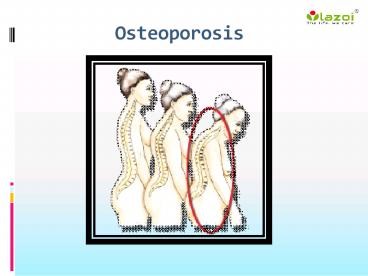An overview of osteoporosis (1) - PowerPoint PPT Presentation
Title:
An overview of osteoporosis (1)
Description:
Osteoporosis is a bone disease which occurs when you lose too much bone make too little bone or both. Bones become so weak that even bending over and coughing can cause a fracture. – PowerPoint PPT presentation
Number of Views:116
Title: An overview of osteoporosis (1)
1
Osteoporosis
2
Osteoporosis
- Osteoporosis is a bone disease which occurs when
you lose too much bone make too little bone or
both. Bones become so weak that even bending over
and coughing can cause a fracture. Fractures
related to osteoporosis are commonly seen in hip,
wrist or spine. Osteoporosis occurs when the
development of new bone doesn't keep up with the
removal of old bone. Osteoporosis affects both
men and women and of all races. But the disease
is particularly seen in Asian women who are older
and past menopause.
3
Factors responsible for osteoporosis
- Bones are in a regular condition of renewal, old
bone is broken down and new one is made. When
you're young, your body develops new bone faster
than it breaks down old bone and your bone mass
increases. Most individuals attain bone mass by
their early 20s. As people grow old, bone mass is
lost faster than it's created. The likeliness
to developing osteoporosis depends partially on
the amount of bone mass attained in youth. The
higher your peak bone mass, the less likely you
are to develop osteoporosis as you age.
4
Symptoms
- Initially, there are no signs of bone loss. But
once the bones become extremely weak, the
symptoms appear - Back pain, caused by a fractured or collapsed
vertebra - Loss of height over time
- A stooped posture
- A bone fracture that occurs much more easily than
expected
5
Treatments
- Treatment for osteoporosis depends on the bone
density test, i.e. an estimate of your risk of
breaking a bone in the next 10 years. If the risk
is low, the treatment will focus on lifestyle,
safety and modifying risk factors for bone
loss. Men and women both are at increased risk
of fracture. The most widely accepted osteoporosis
medications include - Alendronate (Fosamax)
- Risedronate (Actonel, Atelvia)
- Ibandronate (Boniva)
- Zoledronic acid (Reclast)
6
Treatments
Continue
- If the medicine is taken properly, the side
effects such as nausea, abdominal pain,
difficulty swallowing, and the risk of an
inflamed esophagus or esophageal ulcers are less
likely to occur. Hormone-related therapyWhen
estrogen medication is started soon after
menopause, it can help maintain bone density.
However, estrogen therapy can increase a woman's
risk of blood clots, endometrial cancer, breast
cancer and possibly heart disease. Therefore,
estrogen is typically used when menopausal
symptoms also require treatment. In men,
osteoporosis may occur due to age-related decline
in testosterone levels. Testosterone replacement
therapy is the solution but osteoporosis
medications have shown better results.
7
Treatments
Continue
- Other osteoporosis medications include Denosumab
(Prolia) and Teriparatide (Forteo). These
medications are prescribed by the doctor when the
more common treatments for osteoporosis don't
work well enough. Exercise, eating healthy
diet and regular bone density check-ups can
prevent osteoporosis.
8
CONNECT WITH US
- Logon to
- www.lazoi.com
- Like us on Facebook
- https//www.facebook.com/LazoiTheLife
- Follow us on Twitter
- https//www.twitter.com/lazoithelife
- Follow us on Pinterest
- https//www.in.pinterest.com/lazoithelife































